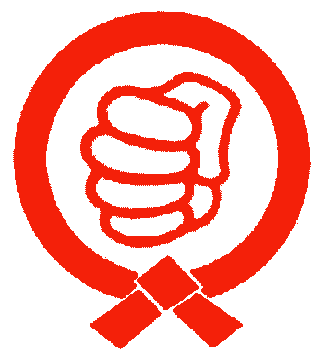
|
GENBUKAN KARATEDO |

|

|
GENBUKAN KARATEDO |

|


"Kamon" are Japanese heraldic symbols. where "mon" may refer to any symbol. "Kamon" refer specifically to family symbols similar to the badges, crests and family crests in European heraldry. It is estimated that there are more than two thousand family emblems derived from patterns drawn from things like flowers and birds. In the Muromachi period and the following Warrior Society (15c-16c), the shape of the family emblem became more abstract and refined than before. At the same time, these family emblems came to be used by the warrior class as heraldic markings. They played a significant role in the warrior society of that time. You may have seen scenes in some movies of battle flags with family emblems waving over the battle field, or of a group of soldiers sitting on benches surrounded by encampment curtains with a family emblem. In the European history of Heraldry, it was controlled and registered as family owned pattern. However, in Japanese history, there was no such legal control but the control was done through the people's mindful respect for others. Rules regulating the choice and use of "mon" were somewhat limited, though the selection of mon was generally determined by social customs. It was considered improper to use a "mon" that was known to be held by someone else, and offensive to use a "mon" that was held by someone of a high rank. When "mon" came into conflict, the lower-ranked person sometimes changed their "mon" to avoid offending their superior. The "mon" held by the ruling clans of Japan, such as Tokugawa's hollyhock "mon" and the Emperor's chrysanthemum "mon", were legally protected from unauthorized usage. Some local governments, associations and businesses (ie Tikkomon) may use "mon" as their logo or trademark, and thus enjoy all the protection as such, but otherwise "mon" are not recognized by law. There are no set rules in the design of a "mon". It most commonly consists of a roundel encircling a figure of plant, animal, man-made, natural or celestial objects, all abstracted to various degrees. Religious symbols, geometric shapes and kanji were commonly used as well. "Mon" are essentially black-and-white; the colour does not constitute part of the design and they may be drawn in any colour. Japanese traditional formal attire generally displays the "kamon" of the wearer. "Mon" add formality to a kimono. A kimono may have one or three or five "mon". The "mon" themselves can be more or less formal; more formal kimono display more numerous "mon", and frequently in a manner so as to make them stand out more. This may help dress up or dress down the formality of a kimono at the wearer's discretion. In the dress of the ruling class, the "mon" could be found on the kimono on both sides of the chest, on both sleeves, and in the middle of the back. On the armour, it could be found on the kabuto (helmet), on the do (cuirass), flags, and various other places. "Mon" could also be found on coffers, tents, fans, and many other items of importance. The family emblem played a significant role as a symbol of lineage. The design of most family emblems was emphasized by enclosing them in a circle. Among the lower classes, it became popular to wear emblems showing a family mark similar to those used by upper-class families. Lower-class families devised many kinds of emblems resembling those used by the upper classes. They even developed a new style of their own. These emblems seem to have served as a sort of business card. Virtually all modern Japanese families have a "mon", though modern usage is rare. Many Japanese may no longer recognize their own family's "kamon". The popularity of emblems declined with the end of the feudal system, especially after the Meiji Restoration of 1868. After the establishment of the New Constitution, people became more interested in individual achievements than keeping track of their lineage. On occasions when the use of "mon" is required, one can try to look it up in the temple registries of their ancestral hometown or consult one of the many genealogical publications available. Professional wedding planners, undertakers and other ritual masters may also offer guidance on finding the proper "mon". Today you may come across your family emblem on the surface of a memorial stone. Don't you think it has a peculiar beauty? You might touch the feelings of your loved ones and most of all you might understand the legacy inherited from generation to generation through the family emblem. |

